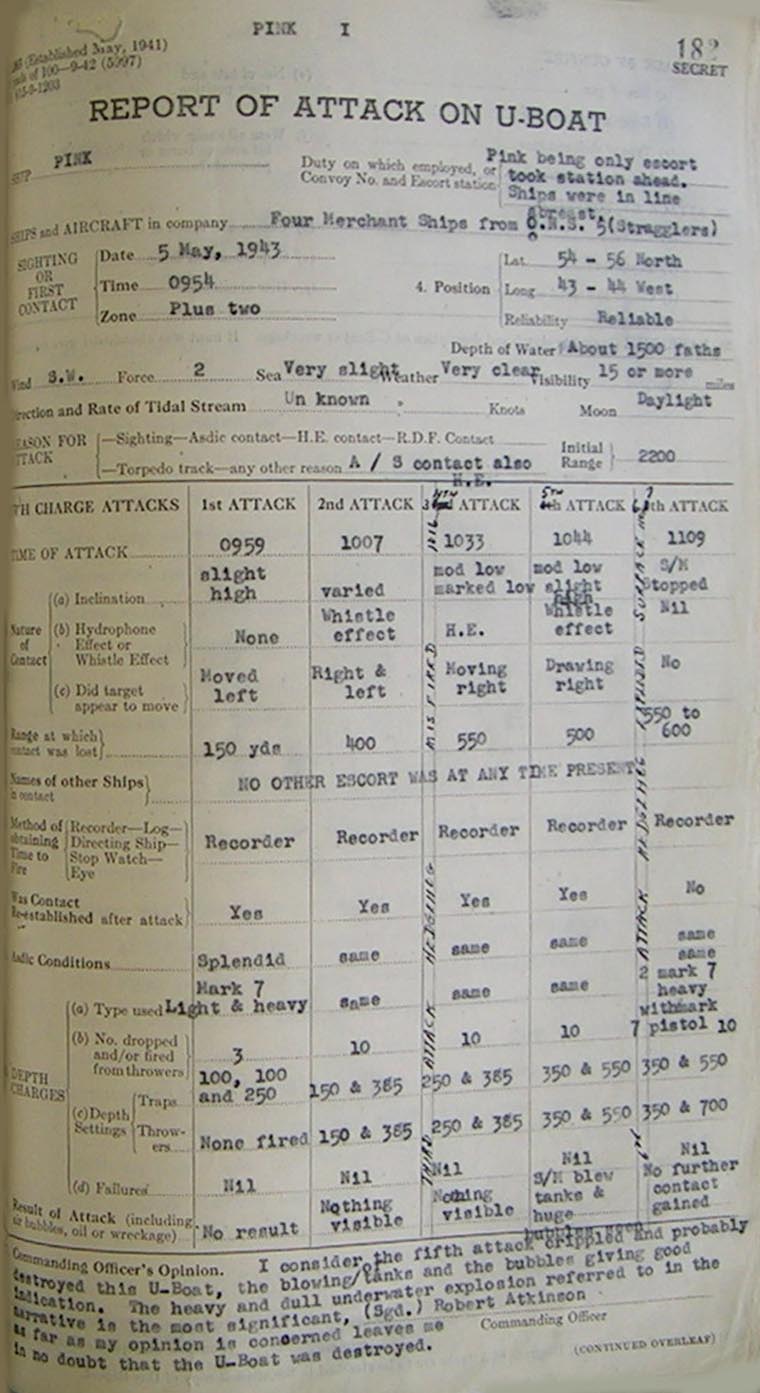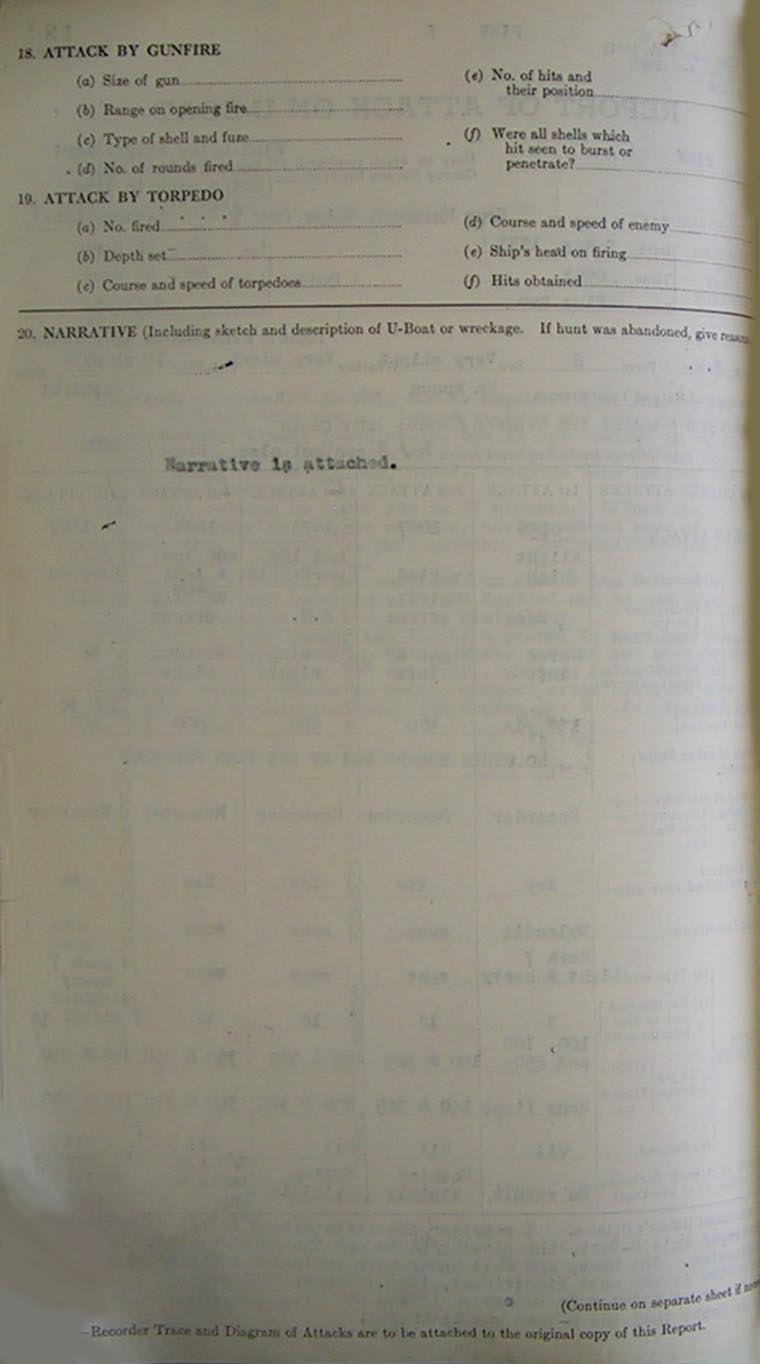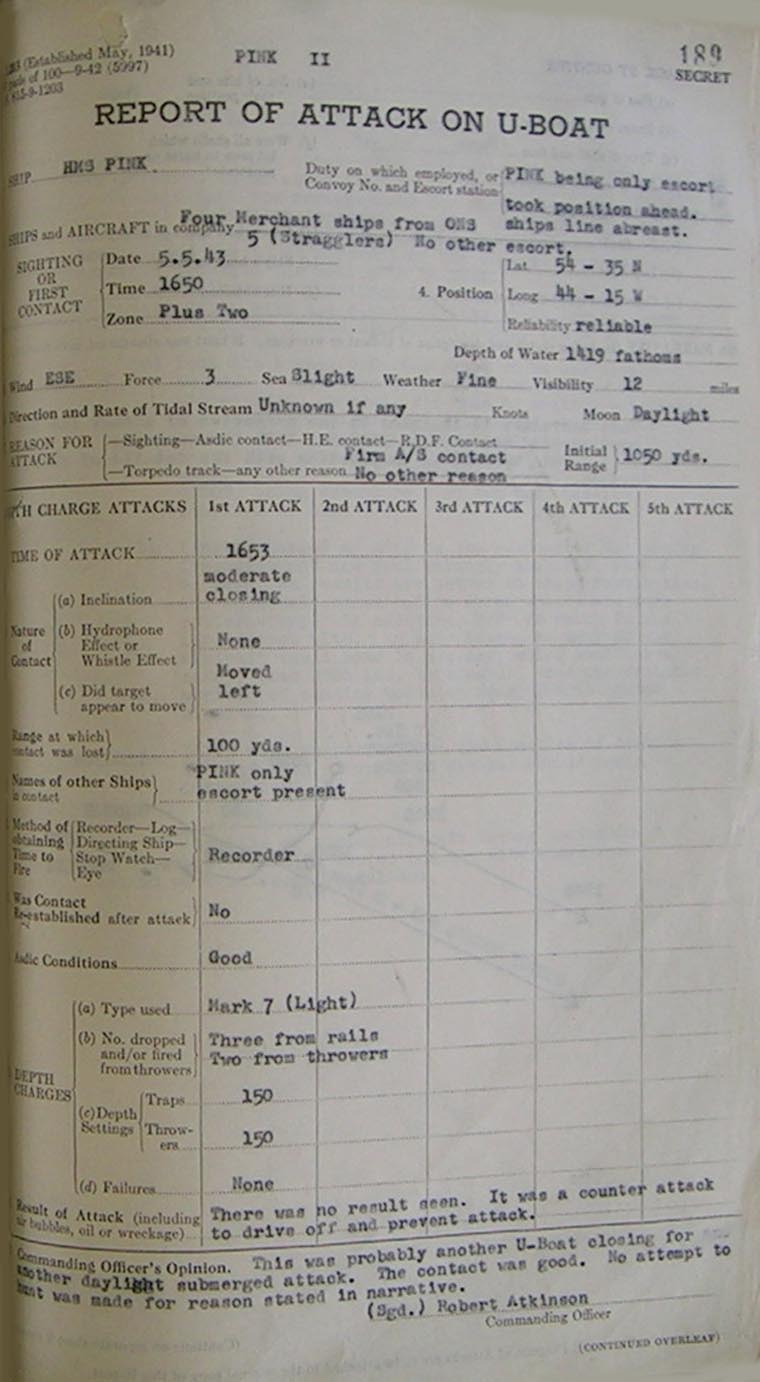PINK 1


Narrative of Attack by HMS PINK on U-boat in Lat. 54-56N Long. 43-44 during the forenoon |
||
of May 5, 1943 whilst escorting four stragglers from Convoy O.N.S. 5. |
||
ALL TIMES ARE THOSE OF ZONE PLUS TWO |
||
| At 0950/5 in position Lat. 54-56N Long. 43-44W Course 245 Speed 8, HMS PINK was the only escort of four stragglers which had been scattered from the Convoy O.N.S. 5 by gales. PINK was zig-zagging about three thousand yards ahead, all four ships being in line abreast. At this time owing to an unsatisfactory fuel situation, PINK was steaming one boiler, the second boiler being banked, I would like, at this stage to stress the fact that PINK was the only escort for four merchant ships, more than 80 miles from the main body of the convoy with no chance of overtaking them and therefore no chance of oiling. If therefore I was to remain with these ships, I considered that the 30% of fuel remaining had to be used most discretely, in view of the general U-boat situation existing at that time. Attacks were considered as probable with consequent high demand on a small amount of fuel; furthermore, I had been given a separate route which increased the distance to be steamed. This further emphasised my already uncertain fuel situation. It was therefore considered necessary to economise fuel, so in addition to steaming on one boiler, one dynamo was shut down and water rationed. | ||
| At 0954, a first class a/s/ contact was obtained bearing 310, 2200 yards, which was immediately classified as submarine. The a/s conditions were splendid, the echoes being by far the cleanest and sharpest I have ever heard. Counter attack was commenced at 11 knots, this being the maximum speed available for four minutes. Echo was slight high, the target moving left with no H.E. Contact was held to 150 yds and at 0959, course 290, three charges were dropped, two being set to 100 feet and one at 250 feet. At that speed more charges could not have been safely dropped without risk of self damage. | ||
| On the run out, course 270 speed 10 knots, contact was regained at 400 yds bearing 110, echo slight high altering to | ||
| slight low at . . . . . . . . | ||
| slight low at 1200 yds, when the ship was swung to port and at 1003 course was 110 to stem the target. The run in commenced at 12 knots, echo same and moving slowly right. Course was altered to 120 speed 14 knots, The target was then steady and then began to draw left, the echo becoming moderately low. Course was altered to 095 to stem the target, speed increased to 15 knots and the range was then 800 yards. The U-boat was heard to be using hydroplanes and/or rudder, apparently diving deeper and turning to port. Contact was lost at 400 yards and at 1006 drawing slowly left; course being then altered to 072 to head off the U-boat; setting s were altered from E (150 & 350) to F (150 and 385). At 1007, ten charges were fired and this attack was considered good. | ||
| At 1008, contact was obtained fine on the port quarter, course being altered to 030 to clear the echo from the wake. Speed was reduced to 9 knots bearing being steady with echo moderately high; the ship was turned to port for the run in attack with the range at 1200 yards and the echo still moderately high. At 1013, the target was stemmed bearing 225, 1000 yards with the pitch the same. The bearing was drawing slowly right and the echo had again changed to slight low. At 1014, the echo was now moderately low. It was realised that the U-boat was again swinging away and trying to get stern on and present his wake to me. The ship wa swung slowly to starboard as the target moved and continued to move right. This attack developed well and at 1016, 24 hedgehog bombs were fired at a range of 250 yards, with 4 degrees of right deflection, the echo at the time of firing being moderately high and moving slowly right. The hedgehog misfired which was extremely disappointing. Course was altered to 295 at 1017 but contact was not regained and at 1009 the ship was swung to starboard, and course set 120 speed 9 knots, steering towards the position we had dropped the flare. Lost contact procedure was carried out but contact was not regained. A sweep of 40 degrees on either side of the last known bearing was carried out unsuccessfully and at 1025 the plot suggested the U-boat bore between 300 and 000. Range about 1600 yards. The ship was turned | ||
| to port . . . . . . . . | ||
| to port and at 1026, speed 9 knots course 320, an a/s sweep 260 - 030 was ordered. At 1027, contact was obtained bearing 350 - 2100 yards. Contact was firm and metallic, echo moderately low and bearing drawing slowly right. This was undoubtedly the U-boat again. The target was stemmed on a course of 355 and speed increased to 12 knots. At 1029, the echo was bearing 000 - 1400 yds. Hydrophone effect was heard on the bearing, the echo pitch becoming marked low and the target still drawing slowly right. Speed was increased to 15 kts. and course set 015 to head off U-boat and at 1031 contact was lost bearing 358 - 550 yards. More good H.E. was heard on the bearing and at 1033 ten charges were fired set to 250 and 385. This was a difficult attack to make as apart from the fact that good H.E. was heard on the bearing in the latter stage, there was little evidence of what the U-boat's movements were during the last stages of the attack. | ||
| At 1034, course was altered to 350 - 12 knots and at 1035 poor a/s contact was obtained bearing 205 - 600 yds. At 1036 the bearing was still 205 and echo moderately low range 1050 yds. At 1038, range had been opened to 1800 yds, echo was now the same. The ship was turned and at 1039 double echoes were obtained bearing 190 - 2000 yds. The target was stemmed and speed reduced to 8 knots, and at 1041 the order to cut right was given with excellent results. Contact was again sharp clear and firm. Speed was slowly increased. The echo was now the same, the bearing drawing right. At 1042, the ship was thrown off to starboard, course 205. At 1043, the echo changed to slight high and H.E. of rudder and/or hydroplane was heard. Contact was lost at 500 yds bearing 215. The ship was thrown off to starboard and steadied on course 230, echo moderately high. At 1044, ten charges were fired set to 350 and 550 feet. This was considered to be a most accurate and successful attack. | ||
| On the run out the submarine was heard to be blowing tanks and at about 500 yds three huge bubbles broke surface almost simultaneously followed by smaller ones in the same area. When the bubbles first broke surface it was thought at first that the U-boat was surfacing, but this was not so. At 1045, course was altered to 260 and poor contact was regained at 800 yds. Considerable water disturbance was | ||
| still going on . . . . . . . | ||
| still going on and at 1048 the ship was turned to close the disturbance for inspection. Course 070 - 14 knots. Occasional "boiling" of the surface was still going on and continued until about three hundred yards short of the area. The disturbed area was seen to much disturb the water in the vicinity being considerably aerated in appearance and green and white like shallow water. Tangible evidence of destruction was greedily and most enthusiastically searched for, but nothing further was seen. It was realised that my little convoy was drawing away and was now some distance ahead and unprotected, but I decided to risk this and to continue with the hunt with the view to a kill, and which I now considered was showing indications of success, with the heavy depth charging having a telling effect. Running out on a course of 085 contact was regained bearing 275, 1000 yds. The U-boat's movements were practically nil and indeed may well have been stopped. The ship was turned and a hedgehog attack commenced at 1058, speed 9 knots. Poor echoes were now obtained the echo being slight low. Contact was lost at 450 yds and at 1102 the hedgehog was fired and all were seen to explode on striking the surface. The general performance of the hedgehog was most disappointing indeed. The ship ran over the contact and contact was regained at 400 yds and course altered to starboard to 290 to clear the contact from the wake. The target was stemmed at 1107, bearing 110, and appeared stopped. The contact appeared to be becoming poorer and seemed to be fizzling out. The final run in was commenced at 1107 course 110 speed 13 knots, contact being lost at about 550 - 600 yds and at 1109 ten charges were dropped set to 350 - 550 - 700 ft. This U-boat was known to be deep and when preparing for this attack one thrower on either side had been loaded with a heavy charge and Mark 7 pistol (four charges painted white are kept ready for this purpose. The ship ran out to about 1500 yds but no further contact was gained except disturbed water echoes. The area was closed again for inspection but nothing further was seen and the hunt was finally abandoned at 1125. Course was set to rejoin 240 - 15 knots, my convoy now being some ten miles ahead. At 1139, a dull and most powerful underwater explosion shook the ship, low in | ||
| note and like . . . . . . . . | ||
| note and like a deep grunt. Initial surprise was felt onboard, but it was recognised immediately to be a deep underwater explosion some distance off. I can only think that this was the submarine, or some part of it, exploding astern deep down, and I consider this to have been the case. I was sorely tempted to turn back and steam to the area of the attack to look for complete evidence of destruction, but this was considered not prudent, with five merchant ships ahead some eight miles (one had joined on the forenoon) and unprotected as they now had been for an hour and a half. I therefore dismissed the idea and continued to rejoin at full speed. At 1253 my worst fears materialized. Still some three miles or so astern a huge column of smoke was seen from the port wing ship, and seen to be the U.S.A. West Madeket, and operation "OBSERVANT" was carried out at 1315. I dropped charges intermittently to keep the U-boat down; I stopped to pick up survivors. At 1400, the whole crew of 61 were onboard. At 1405, I sank the wreck with the two starboard throwers set to 50 feet. She split in two and sank leaving no trace, which surprised me as she had some 540 tons of oil bunkers on board at the time of sinking. There was great controversy among the survivors as to which side this ship had been torpedoed. It appears that there was a 24" hole on the starboard side with a great portion of the port side torn away by the explosion. The splash and smoke came from the port side and I think it probable that she was torpedoed from the port side. At 1530, PINK was again in station having collected the four remaining ships; DUNSEY, DIRECTOR, YEARBY and Norwegian GUDVOR. YEARBY had joined that morning just before noon. At 1630, firm a/s contact was obtained at 1000 yds ahead of the convoy which was counter attacked at 1653 with 5 charges set to 150 feet. It is pointed out that 43 depth charges had been expended that morning during the hunt 15 had been dropped at other times leaving 21 remaining. My future commitments were unknown and therefore 5 charge patterns were considered to be the wisest policy. This contact was depth charged some 300 yds ahead of the second ship from the left, there being four ships in line abreast. Some confusion was seen among them but their behaviour | ||
| was excellent . . . . . . . . | ||
| was excellent. One ran over the depth charge disturbance. Contact was not immediately regained in the wakes and this time I was more than anxious to regain station without delay. Further attacks were expected and station ahead was resumed immediately. TAY had been asked for assistance but without success. She was S.O. of the main body and was beset by U-boats herself. It will be realised that an acute shortage of depth charges and oil fuel, and the probability of night attack, the best I could hope to do on my own was to drive off any further attacks, and not allow myself to be drawn off. I considered my best tactics for the night to be evasive action; various courses for the night were therefore arranged with good result as the night passed without incident, the visibility being horribly good. HMS SENNEN was instructed to join and support PINK and at 0945Z/6 she reported as having attacked a U-boat close astern, some 12 miles. She was hunting. HMS SENNEN joined at 2300Z/6 and informed me that she had attacked two U-boats close astern of my convoy. | ||
| No further attacks developed, possibly due to the dense fog and ice that we met the following night and then on. (Attention is invited to my 052101Z and my 051420Z both to C-in-C W.A.) | ||
| (Sgd.) R. Atkinson | ||
| Lieutenant Royal Naval Reserve | ||
| COMMANDING OFFICER | ||
PINK 2
